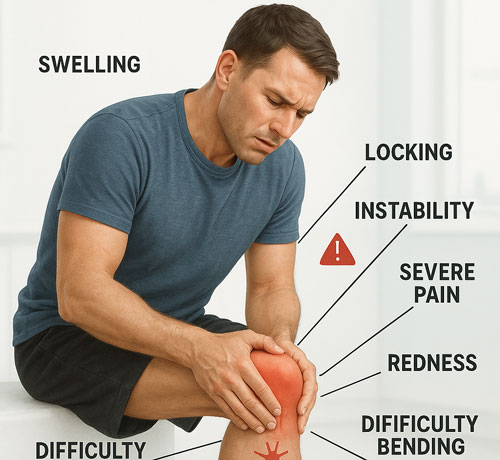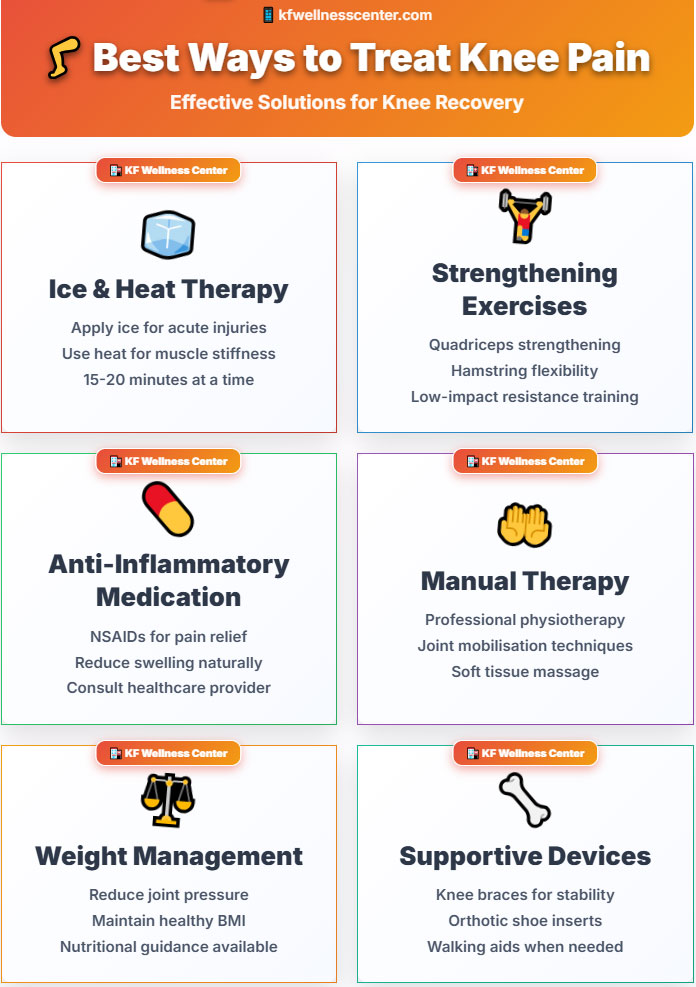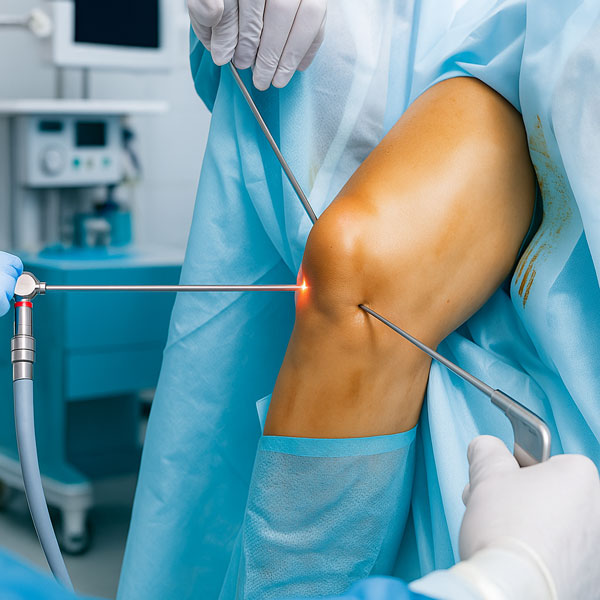Best Knee Pain Treatments can help you get back on your feet faster and keep your joints healthy for the long haul. From quick home remedies to advanced non‑surgical therapies, the right mix depends on your pain type and lifestyle. Rest, ice or heat therapy, and gentle stretching can ease minor injuries. For lingering pain, physiotherapy, targeted strengthening, and supportive braces improve stability and reduce inflammation. Injections like corticosteroids, hyaluronic acid, or platelet‑rich plasma often deliver relief without the need for surgery. Pairing these treatments with lifestyle changes maintaining a healthy weight and eating cartilage‑friendly foods offers sustainable protection. Don’t ignore persistent swelling, instability, or severe discomfort; consult a professional early to prevent bigger issues. With smart choices and timely care, most people can manage pain, restore mobility, and avoid invasive procedures, keeping their knees strong and active for years to come.
what will you read…
Why It Is Important to Understand Knee Pain Treatments؟
Knowing the right knee pain treatments is more than a matter of comfort. it can protect long‑term joint health and mobility. In Canada’s active communities, knee strain is common among both young athletes and older adults. Early awareness of treatment options, from simple home care to advanced non surgical therapies, helps prevent small aches from becoming chronic injuries. Understanding when to use ice therapy, stretching routines or physiotherapy can keep swelling down and recovery on track. Knowledge also empowers patients to discuss targeted injections or supportive braces with their health provider, creating a tailored plan. Informed choices mean fewer complications, faster results, and stronger knees for everyday life.
Who Is More at Risk of Developing Knee Pain
Knee pain affects people across all ages, but certain groups are more at risk. Athletes in sports like hockey, soccer and skiing face repeated strain from high‑impact movements. Older adults often experience cartilage wear, making everyday steps challenging. Workers in physically demanding jobs, such as construction or caregiving, can develop inflammation from overuse. Carrying extra body weight adds constant pressure to the knee joint, increasing injury risk. Those with past joint injuries or conditions like arthritis should stay alert to new symptoms. In Canada’s climate, icy surfaces during winter also heighten the danger of sudden knee trauma. Recognizing risk factors early can guide smart prevention and timely professional care.
Anatomy and Function of the Knee
The knee is one of the body’s most sophisticated joints, built to handle weight, movement, and impact. It connects the thigh to the lower leg through a precise arrangement of bones, ligaments, tendons, cartilage, and muscle. This joint allows flexion, extension, and slight rotation, enabling walking, running, and climbing. Its design balances strength with flexibility, making it vital for daily activities and sports. Protecting knee health means understanding how each part works together. When even one structure is injured.whether it’s bone, ligament, or cartilage. the harmony is disrupted, causing pain or instability. A clear grasp of knee anatomy lays the foundation for effective treatment and prevention strategies.

Bone Structure of the Knee
The knee’s bony framework consists of the femur (thigh bone), tibia (shin bone), and patella (kneecap). These bones meet at the joint surfaces, cushioned by smooth cartilage to reduce friction and absorb shock. The femur forms the upper hinge, while the tibia supports body weight from below. The patella sits in front, acting as a shield and improving leverage for thigh muscles. Together, they create a sturdy yet mobile structure, guided by the surrounding ligaments and muscles. Injuries or wear to any of these bonesfrom fractures to degenerative changes.can quickly impair movement. Understanding this skeletal foundation is essential for diagnosing pain and selecting the best knee pain treatments.
Ligaments and Tendons
Ligaments and tendons are the knee’s stabilizers and connectors, each serving a unique role. Ligaments, such as the ACL, PCL, MCL, and LCL, link bones together, keeping the joint steady during motion. Tendons connect muscle to bone, transmitting power for movement. The quadriceps tendon anchors the thigh muscles to the patella, while the patellar tendon connects the kneecap to the tibia. These strong fibres endure daily stress from walking, running, and bending. Damage from sudden twists, overuse, or impact can lead to instability or pain. Healthy ligaments and tendons maintain knee alignment, protect cartilage, and ensure efficient motion making them a critical focus in knee pain prevention and rehabilitation.
Common Causes of Knee Pain
.
| Cause | Typical Risk Groups |
|---|---|
| Sports Injuries | Athletes, active adults |
| Osteoarthritis | Older adults, people with prior knee injuries |
| Tendonitis | Manual labourers, athletes |
| Ligament Tears | Athletes, outdoor workers |
| Meniscus Tears | Athletes, seniors |
| Excess Weight | People with obesity |
| Inflammatory Conditions | All age groups |
Warning Signs!
- Sudden, intense pain following an injury
- Persistent swelling that does not improve within 48 hours
- Loss of ability to fully bend or straighten the knee
- Sensation of instability or “giving way” in the knee joint
- Noticeable deformity or change in knee shape
- Redness, warmth, or fever alongside knee pain
- Grinding, popping, or locking in the knee during movement
- Pain that worsens at night or disrupts sleep
- Difficulty bearing weight on the affected leg
- Numbness or tingling around the knee or down the leg

Best Ways to Treat Knee Pain
Home remedies and primary care remain among the best ways to treat knee pain, especially for mild injuries and early arthritis. Canadians often begin with rest, applying ice packs for 15 to 20 minutes, several times a day to reduce swelling. Elevating the leg and using light compression can improve circulation and relieve discomfort. Gentle stretching and low‑impact activities such as swimming maintain flexibility while avoiding strain. Over‑the‑counter pain relievers, if taken responsibly, can control symptoms during recovery. Early, attentive care prevents small injuries from becoming chronic problems. A key factor is listening to your body: slowing down or pausing activities at the first sign of discomfort. Prevention is built into every home remedy — the goal is to heal without pushing the knee beyond safe limits.

Specialized Non‑Surgical Treatments
Specialized non‑surgical treatments provide structured, professional approaches to recovery without the risks of surgery. In Canada, these methods are popular among athletes, seniors, and those with early osteoarthritis. Therapies include transcutaneous electrical nerve stimulation (TENS), shockwave therapy, laser therapy, and Tecar therapy, each designed to improve joint function and relieve pain. Hydrotherapy uses warm water to relax muscles and reduce inflammation, while manual therapy restores natural movement patterns. Many clinics offer tailored exercise programs focusing on muscle balance around the knee. These treatments often combine technology with precise human skill, striking a balance between science and comfort. They fit patients who seek faster healing without downtime, especially when paired with lifestyle changes like weight management and ergonomic adjustments in daily tasks.
Medicinal and Supplement Based Treatments
Medicinal and supplement‑based treatments aim to target pain and support joint health from within. Canadian physicians may recommend non‑steroidal anti‑inflammatory drugs (NSAIDs) to control swelling and discomfort, along with topical gels or creams for localized relief. Supplements such as glucosamine, chondroitin, collagen, and omega‑3 fatty acids are often prescribed to nourish cartilage and slow deterioration, especially in osteoarthritis. Vitamin D and calcium maintain bone strength, while turmeric and other natural anti‑inflammatories may complement medical care. It is crucial to follow professional guidance, as improper dosage or drug interactions can create complications. These treatments work best as part of a wider plan — combining medication and nutrition with exercise ensures long‑term results. Patients who commit to consistent intake often experience reduced stiffness and improved mobility over time.
Movement Therapy
Physiotherapy and movement therapy remain cornerstone solutions in Canadian orthopaedics, especially for reducing knee pain without invasive procedures. Skilled physiotherapists design individualized exercise plans that strengthen supporting muscles, improve joint stability, and increase flexibility. Techniques may include controlled stretching, resistance training, balance exercises, and low‑impact cardio like cycling. Movement therapy emphasizes deliberate, mindful motion to retrain healthy patterns and prevent reinjury. Modalities such as ultrasound, electrical stimulation, and therapeutic taping add precision to physical rehabilitation. This approach benefits not only acute injury cases but also chronic arthritis sufferers, giving them tools to regain confidence in mobility. Patients often report improved endurance and pain control after weeks of consistent sessions, underscoring the value of professional guidance in every phase of recovery.
Massage Therapy
Massage therapy offers both immediate relief and long‑term benefits for people living with knee pain in Canada. Performed by trained therapists, it can reduce muscle tension, improve blood flow, and support lymphatic drainage around the joint. Techniques such as deep tissue massage, myofascial release, and sports massage target different causes, from overuse injuries to post‑exercise stiffness. When paired with stretching, massage fosters better flexibility and reduces scar tissue formation. This hands‑on care also triggers relaxation responses that lower overall pain perception. Many clinics integrate massage into broader rehabilitation programs, complementing physiotherapy or specialized non‑surgical treatments. Regular sessions may help athletes maintain peak performance and allow seniors to stay active without worsening joint stress. The method shines in its dual focus: comfort today and resilience tomorrow.
Advanced Injectable Treatments
Advanced injectable treatments are gaining momentum across Canada for their ability to deliver targeted healing directly to the knee joint. Platelet‑rich plasma (PRP) uses a patient’s own blood components to stimulate tissue regeneration, often reducing recovery time. Ozone therapy aims to improve oxygenation and reduce inflammation, while gel injections provide cushioning that mimics natural joint fluid. These methods suit individuals with early to moderate arthritis, sports injuries, or cartilage damage who are seeking a middle ground between medication and surgery. Procedures are typically quick, with minimal downtime, but require precision and professional expertise to ensure safety. When combined with physiotherapy or lifestyle improvements, injectables can extend mobility and reduce pain for months or even years, making them a strong option for proactive patients.
Advantages and Disadvantages of Each Method
| Method | Advantages | Disadvantages |
|---|---|---|
| Home Remedies | Affordable, easy, good for mild cases | Less effective for severe injuries |
| Non‑Surgical Treatments | Fast results, low downtime | Higher cost, multiple sessions |
| Medicinal / Supplements | Reduce pain, support cartilage | Side effects, limited alone |
| Physiotherapy | Builds strength, prevents reinjury | Time‑consuming, needs commitment |
| Massage Therapy | Improves circulation, relaxation | Temporary relief only |
| Injectable Treatments | Targeted, lasts months | May fade, repeat needed |
Surgical Methods for the Knee
Surgical methods for the knee are often recommended when non‑surgical options fail to restore mobility or relieve pain. In Canada, these procedures range from minimally invasive arthroscopy to complete or partial joint replacement. Each method is chosen based on the patient’s condition, lifestyle, and long‑term mobility goals. Surgery aims to repair damaged structures, remove debris, or replace worn cartilage surfaces. Advances in technology have reduced operation times and improved recovery rates, but surgery still carries risks such as infection or complications. Decision‑making involves careful consultation between patient and specialist, ensuring that the benefits outweigh the potential drawbacks.
Arthroscopy
Arthroscopy is a minimally invasive knee surgery widely used across Canada for treating cartilage tears, ligament damage, and persistent swelling. Using a small camera and specialized tools, surgeons operate through tiny incisions, avoiding the trauma of open surgery. This approach allows for quicker recovery, less pain, and minimal scarring. Common candidates include athletes with sports injuries and older adults with early joint damage. Post‑operative care includes light exercise, physiotherapy, and regular monitoring to maintain joint function. Arthroscopy’s success lies in precision — targeting only the damaged tissue while preserving healthy structures, making it a preferred choice for many knee patients.

Total or Partial Joint Replacement
Total or partial joint replacement is a life‑changing solution for advanced arthritis or severe joint deterioration. In Canadian orthopaedic practice, surgeons replace damaged bone and cartilage surfaces with durable artificial components. Partial replacements target only the affected area, preserving more of the natural knee, while total replacements address widespread damage. These surgeries restore mobility, reduce chronic pain, and can last for decades. Recovery requires structured rehabilitation, weight management, and strict adherence to medical advice. While highly effective, replacement surgery carries higher risks and longer downtime than arthroscopy, making proper patient selection vital for long‑term treatment success.
Post Surgical Monitoring and Care
Post‑surgical monitoring and care are essential to protect results and prevent complications. In Canada, patients follow a tailored recovery plan involving wound checks, physiotherapy, pain management, and gradual return to daily activities. Regular follow‑up appointments ensure proper healing and detect early signs of infection or implant issues. Lifestyle adjustments such as maintaining a healthy weight, balanced nutrition, and safe exercises help extend the life of the surgical repair. Support devices like knee braces may provide added stability during recovery. Successful outcomes depend on consistent communication with healthcare providers and strict adherence to rehabilitation protocols, safeguarding mobility for years ahead.
Steps of a Knee Pain Prevention Diet
The steps of a knee pain prevention diet provide a practical roadmap for joint protection through balanced eating. Begin the day with water or herbal tea to support joint lubrication and add vitamin C‑rich fruit for collagen growth. For lunch, combine lean protein with leafy greens and whole grains to reduce inflammation and boost muscle strength. Afternoon snacks like almonds, walnuts, or berries deliver healthy fats and antioxidants. Dinner should include calcium sources and omega‑3‑rich foods such as salmon to reinforce bone density. By following these dietary stages regularly, Canadians can reduce stress on knee joints, maintain mobility, and enjoy a healthier, more active lifestyle for years to come.
step by step preventive diet plan for knee health
Start Your Day with Joint Friendly Hydration
Begin every morning with a glass of water or herbal tea to rehydrate your body after sleep. Proper hydration supports joint lubrication and reduces stiffness. Adding lemon provides vitamin C for collagen production. Avoid sugary beverages at breakfast, as they can trigger inflammation and lead to energy crashes.
Build a Nutrient Dense Lunch
Choose a balanced meal with lean protein such as grilled fish or chicken, paired with leafy greens rich in antioxidants. Include whole grains like quinoa or brown rice for sustained energy. Limit fried foods and excess salt to keep inflammation low and circulation healthy.
Snack Smart in the Afternoon
Opt for nuts, seeds, or fresh fruit instead of processed snacks. Almonds and walnuts offer healthy fats, while berries deliver polyphenols that protect cartilage. Avoid sugary pastries or chips, which add unnecessary calories and increase knee pressure.
Support Bone Health at Dinner
A well‑rounded dinner can include steamed vegetables, legume‑based dishes, and a calcium source such as low‑fat dairy or fortified plant milk. Incorporate omega‑3‑rich options like salmon twice a week to fight joint inflammation. Keep portion sizes moderate to prevent weight gain.
End the Day with Anti Inflammatory Support
Prior to bedtime, enjoy a small cup of chamomile or turmeric tea. These herbal options soothe inflammation and aid recovery while you sleep. Avoid heavy late‑night snacks, which can disrupt digestion and add strain to your joints over time.
Knee Pain Prevention Tips
- Maintain a healthy body weight to reduce stress on knee joints.
- Engage in regular low‑impact exercise such as swimming, cycling, or walking.
- Strengthen leg muscles with targeted resistance training and stretching.
- Wear supportive footwear designed for your activity and terrain.
- Avoid prolonged sitting by taking short movement breaks throughout the day.
- Practise proper posture when standing, walking, or lifting heavy objects.
- Warm up before physical activity and cool down afterwards.
- Include nutrient‑rich foods to support cartilage and bone health.
- Stay hydrated to keep joint tissues lubricated.
- Limit high‑inflammation foods such as processed sugar, trans fats, and excess salt.
Frequently Asked Questions About the Best Knee Pain Treatments
Can knee pain be linked to other health conditions?
Yes. Chronic knee pain can sometimes be a symptom of systemic issues such as gout, rheumatoid arthritis, or thyroid disorders, which require medical evaluation.
Is weather change really a cause of knee discomfort?
Some people experience increased joint stiffness during cold, damp weather. It may be due to changes in barometric pressure affecting joint tissue sensitivity.
How does mental health influence knee pain recovery?
Stress and anxiety can slow recovery by increasing muscle tension and reducing motivation for physical therapy, making holistic care important.
